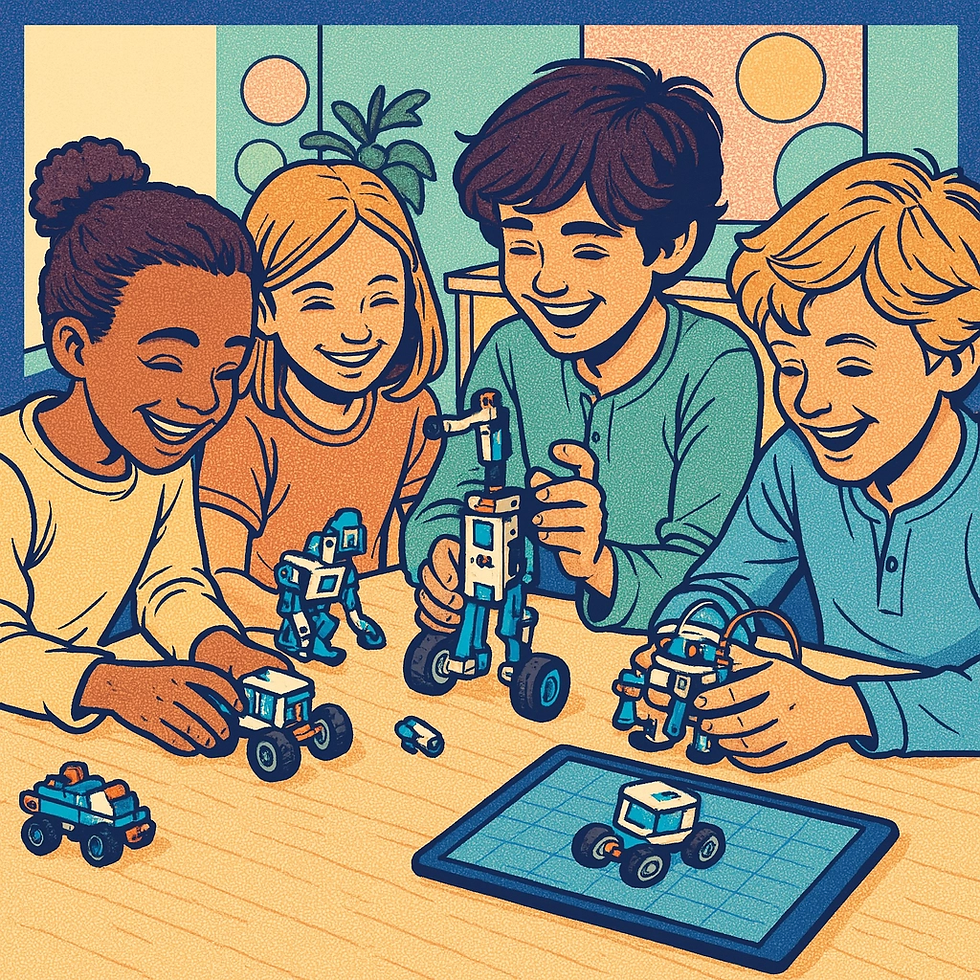Beyond the Screen: Balancing AI, Real-World projects, and social connection in hands-on STEM learning
- Gaurav Sangal

- Aug 25
- 3 min read

The power of hands-on STEM Learning
Let’s face it: the best way to learn how things work is by rolling up your sleeves and getting your hands a little dirty (sometimes literally). Hands-on learning is the heart of impactful STEM education. When students program robots to race through obstacle courses, or design their own prosthetic using daily available objects, or create their own LEGO contraption related to a physics concept, they turn abstract concepts into tangible, memorable experiences.
This type of learning does more than just reinforce academic content. It shapes curious minds into confident creators, fosters inventive thinking, and helps kids connect what happens in class to what happens in the real world. Instead of memorizing formulas, students become active investigators, testing hypotheses and learning from every “oops” and “aha!” moment along the way.

Where AI Fits in: More than just fancy tech
Artificial Intelligence might sound like something from a sci-fi movie, but it’s quickly becoming part of kids’ everyday learning journeys. In STEM classrooms and after-school programs, AI can simulate complex phenomena, grade quizzes instantly, and even offer tailored hints when students get stuck. But here’s the thing: AI isn’t here to replace classic hands-on projects - it’s here to support them.
By using AI-powered simulations, students can test out wild ideas before building real prototypes. Curious about solar car designs? AI tools can help model energy outputs. Wonder if that bridge can support more weight? Run a virtual test! These digital experiences boost student confidence, making hands-on building safer (and less intimidating) when they head to the workbench.
Blending Digital with the Physical: Getting the Balance Right
The magic happens when AI tools and real-world projects work together. For example, at The STEM Lab, we love starting with a simulation of a circuit design before launching into a physical circuit that is carrying electric current. Here’s how it might look:
Planning: Students use AI to design and tweak a circuit in a virtual space.
Testing: The simulation checks for glitches, giving instant feedback.
Building: Armed with insights, students construct physical circuits.
Iterating: Real-life results feed back into the digital simulation, sparking new ideas.
In this blended model, technology accelerates the design process - while hands-on work cements the skills, encouraging problem-solving and perseverance.
“AI helps our students safely experiment and learn from virtual ‘failures,’ but only real-world projects let them feel the excitement of building and the pride in fixing what doesn’t work the first time.”— The STEM Lab Instructor

The Secret Ingredient: Social Connection
Don’t underestimate the human side of STEM learning! While AI can analyze patterns, suggest improvements, and score quizzes, it can’t replace what happens when students gather around a table, share ideas, and laugh over goofy robot fails. Collaboration is at the heart of every great scientific breakthrough-and every STEM club meeting.
Hands-on group projects teach kids how to:
Listen to different perspectives
Divide tasks according to strengths
Solve conflicts and compromise
Celebrate wins and learn from losses together
In today’s tech-enabled classrooms, balancing screen time with real-world teamwork is essential. Whether coding together or working out the kinks in a group project, kids build friendships, communication skills, and self-confidence. And that’s something you just don’t get from working in isolation.
Guiding Kids to Use AI Responsibly
As cool as it is, AI isn’t a shortcut. At The STEM Lab, we talk openly with students about the right way to use these tools:
Use AI to learn more deeply - not to skip steps or just get the “right” answer
Share what you discover with teammates
Ask for help if you don’t understand a suggestion from an AI
Double-check AI results by testing ideas in the real world
Think about the ethical impact of AI decisions, from privacy to fairness
By setting these ground rules, we help students see AI as an exciting sidekick instead of a substitute for their own creativity and effort.

Looking Ahead: The Future is Balanced
At The STEM Lab, we are passionate about helping students build both tech fluency and real-world confidence. We believe the best STEM experiences happen when AI inspires curiosity, hands-on work inspires persistence, and teamwork brings everything to life.
If you are curious about how we blend these approaches in our programs, check out our on-site programs or visit us at The Innovation Hub. Let’s help the next generation go beyond the screen—and out into a future they will be confident and excited to create!




Comments